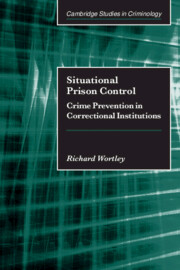Book contents
- Frontmatter
- Contents
- List of figures and tables
- Foreword
- Acknowledgements
- Part I Theoretical foundations
- 1 Introduction: why situational prison control?
- 2 Situational theories of prison behaviour
- 3 Situational methods of prison control
- 4 A model of situational prison control
- Part II Specific behaviours
- List of references
- Index
4 - A model of situational prison control
Published online by Cambridge University Press: 22 September 2009
- Frontmatter
- Contents
- List of figures and tables
- Foreword
- Acknowledgements
- Part I Theoretical foundations
- 1 Introduction: why situational prison control?
- 2 Situational theories of prison behaviour
- 3 Situational methods of prison control
- 4 A model of situational prison control
- Part II Specific behaviours
- List of references
- Index
Summary
In criminology, rational choice perspective (Cornish and Clarke, 1986; Clarke, 1992, 1997) is the dominant model for explaining the relationship between situations and offending behaviour. According to the rational choice account of crime, potential offenders weigh up the costs and benefits of illegal behaviour as they judge them to be at the crime scene and then act on the basis of the outcome of this calculus. Rational choice perspective, in turn, provides the rationale for the opportunity-reduction approach to situational crime prevention. Within this approach, crime prevention is viewed in terms of increasing the perceived costs and reducing the perceived benefits of offending so that criminal behaviour might be judged by the potential offender to be an unattractive option.
However, the distinction made in chapter 2 between situational precipitators and situational regulators represents a significant point of departure from these conventional accounts of situational behaviour and its control. The identification of these two sorts of situational influence suggests that rational choice perspective and the opportunity-reduction model are telling only half the story. It was argued that situational theories of prison disorder rely not just on the role of the perceived outcomes of action (i.e. cost-benefit analysis), but also on the role of situational factors that initiate behaviour an individual may otherwise not have undertaken. Similarly, approaches to situational prison control have involved both concerns with restricting opportunities for misbehaviour (manipulating situational regulators) and with reducing the institutional pressures to misbehave (controlling situational precipitators).
- Type
- Chapter
- Information
- Situational Prison ControlCrime Prevention in Correctional Institutions, pp. 55 - 76Publisher: Cambridge University PressPrint publication year: 2002



